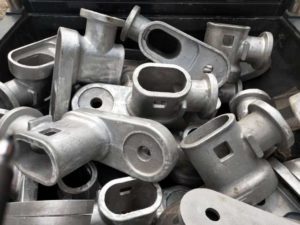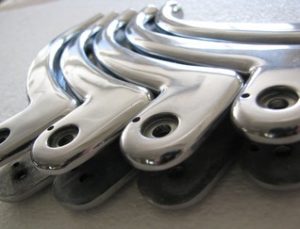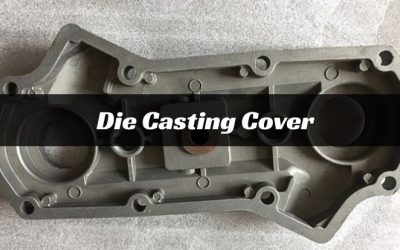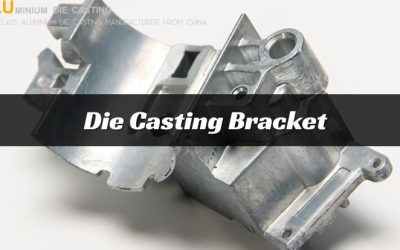What Is A Sand Casting
A sand casting or a sand molded casting is a cast part produced by forming a mold from a sand mixture and pouring molten liquid metal into the cavity in the mold. The mold is then cooled until the metal has solidified. In the last stage the casting is separated from the mold. There are six steps in this process:
1. Place a pattern in sand to create a mold.
2. Incorporate a gating system.
3. Remove the pattern.
4. Fill the mold cavity with molten metal.
5. Allow the metal to cool.
6. Break away the sand mold and remove the casting.
There are two main types of sand used for molding. “Green sand” is a mixture of silica sand, clay, moisture and other additives. The “air set” method uses dry sand bonded to materials other than clay, using a fast curing adhesive. When these are used, they are collectively called “air set” sand castings to distinguish these from “green sand” castings. Two types of molding sand are natural bonded (bank sand) and synthetic (lake sand), which is generally preferred due to its more consistent composition.
With both methods, the sand mixture is packed around a master “pattern” forming a mold cavity. If necessary, a temporary plug is placed to form a channel for pouring the fluid to be cast. Air-set molds often form a two-part mold having a top and bottom, termed Cope and drag. The sand mixture is tamped down as it is added, and the final mold assembly is sometimes vibrated to compact the sand and fill any unwanted voids in the mold.
Then the pattern is removed with the channel plug, leaving the mold cavity. The casting liquid (typically molten metal) is then poured into the mold cavity. After the metal has solidified and cooled, the casting is separated from the sand mold. There is typically no mold release agent, and the mold is generally destroyed in the removal process.
The accuracy of the casting is limited by the type of sand and the molding process. Sand castings made from coarse green sand impart a rough texture on the surface of the casting, and this makes them easy to identify. Air-set molds can produce castings with much smoother surfaces. Surfaces can also be ground and polished, for example when making a large bell. After molding, the casting is covered in a residue of oxides, silicates and other compounds. This residue can be removed by various means, such as grinding, or shot blasting.
During casting, some of the components of the sand mixture are lost in the thermal casting process. Green sand can be reused after adjusting its composition to replenish the lost moisture and additives. The pattern itself can be reused indefinitely to produce new sand molds. The sand molding process has been used for many centuries to produce castings manually. Since 1950, partially-automated casting processes have been developed for production lines.
GC Mold is a professional supplier for die casting parts and machined part which is widely used for Automobile, Medical, earthmover, petroleum, electricity Industry, and in long-term business with foreign customers from North America and west Europe, we are exactly know what’s the customer requirement when they provide drawings and material specification. And our engineering dept. can suggest the best process and technology to make the component or any design changing if necessary.
Most of our products are exported to Canada, USA, and west Europe Germany, France, Denmark, Italy, Norway,Turkey, Finland, Switzerland, etc. and win good reputation among our customers.
GC cover different foundries and machining factories based on different casting process: investment casting, sand casting and high pressure die casting, aluminum gravity casting, as well as precision machining with CNC machines.
Are you looking for aluminum sand casting and other casting service? contact us to get price, we are die casting China manufacturer, offering aluminum die casting, magnesium die casting, zinc die casting, cast aluminum and cast iron to the world market.







0 Comments